The project of an engineering tank Churchill Ardeer Aggie (UK)
The Churchill AVRE engineering tank carried a Petard-type mortar, which allowed it to fire 290 mm ammunition with a charge weighing 12,7 kg. The firing range of such a gun reached 72 m, and reloading was carried out manually, and the loader did not have to remain without the protection of the armored hull. During the landings in Normandy in June 1944 and in subsequent battles, a special vehicle based on the Churchill tank proved its potential and demonstrated the ability to perform various tasks of escorting troops and ensuring their combat work. However, back in 1943, the Churchill AVRE project was criticized. A number of features of this engineering tank did not receive the approval of the British military. It was proposed to correct the shortcomings in a new project of a similar purpose.
Potential operators in the first place were not satisfied with the characteristics of the Petard mortar. When using ammunition of acceptable power, the gun did not differ in high firing range and ease of use. To fire a shot, one had to approach the target at 70 m or closer, which was associated with risks. During the reloading of the gun, the loader remained under the protection of the hull and doors of his hatch, but still high risks remained. Thus, in the new project, which received the designation Churchill Ardeer Aggie, it was necessary to increase the firing range of the explosive charge, as well as improve the safety of the crew. These were the goals of the new project.
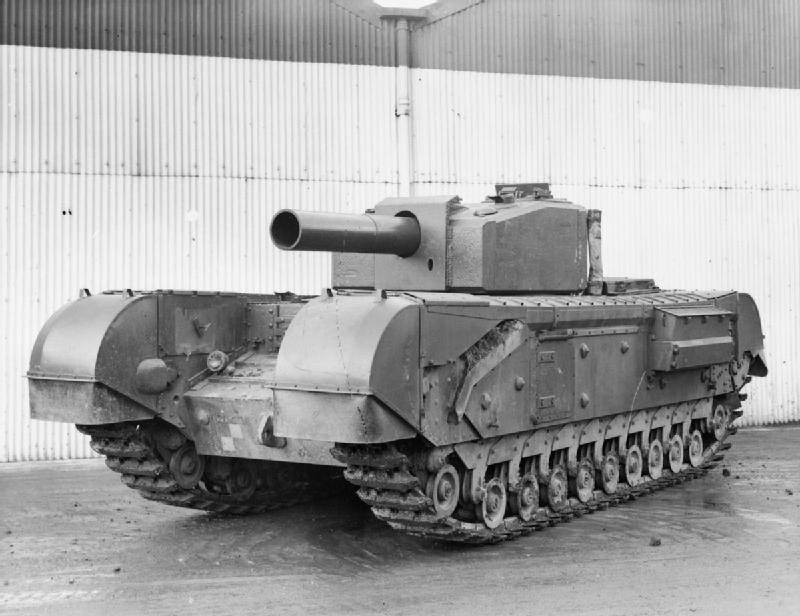
The only prototype of the tank is the Churchill Ardeer Aggie. Photo Shushpanzer-ru.livejournal.com
Preliminary studies of the new project have shown that when creating a new car for the Royal Engineers Corps, one can do without reworking the combat compartment. The hull, power plant, chassis and other elements of the chassis could be borrowed from serial technology without changes. In addition, it was possible to use the existing tower, the design of which should have made some minor changes.
The heavy infantry tank Churchill had great potential in terms of being used as a vehicle for engineering troops due to the presence of powerful armor and acceptable mobility characteristics. In the construction of the hull and turret, armor plates of various shapes and sizes were used with a maximum thickness of up to 102 mm - such detail sheets were available in the protection of the frontal projection. The sides were made of parts with a thickness of 76 mm. The turret protection, with some changes, repeated the design of the hull.
The chassis of the Churchill tank had a classic layout with a front control compartment, a fighting compartment in the center of the hull and an engine-transmission compartment in the stern. A curious feature of the tank was the use of a large width hull with developed side niches. These parts of the hull were covered by a caterpillar, which made it possible to increase the dimensions of the internal volumes of the hull to the maximum possible values without negatively affecting other features of the machine.
The tank was equipped with a 350 hp Bedford Twin-Six gasoline engine. and a mechanical transmission that transmits torque to the rear drive wheels. To simplify the control of the machine, some elements of the transmission were equipped with servo drives that reduce the force on the levers. With a tank combat weight of about 38 tons, the existing engine could provide acceptable, according to the customer, mobility characteristics. The maximum speed on the highway reached 25 km / h, on rough terrain the speed decreased.
The Churchill tank had a recognizable undercarriage, the design of which was associated with the original architecture of the hull, equipped with large side niches. On the sides of the hull there were 11 double road wheels on an individual spring suspension. Guide wheels were mounted in front of the hull on remote systems, and drive wheels were mounted in the stern. The caterpillar covered the side of the hull. Its upper branch was supposed to move along the guides on the roof of the side niche of the hull.
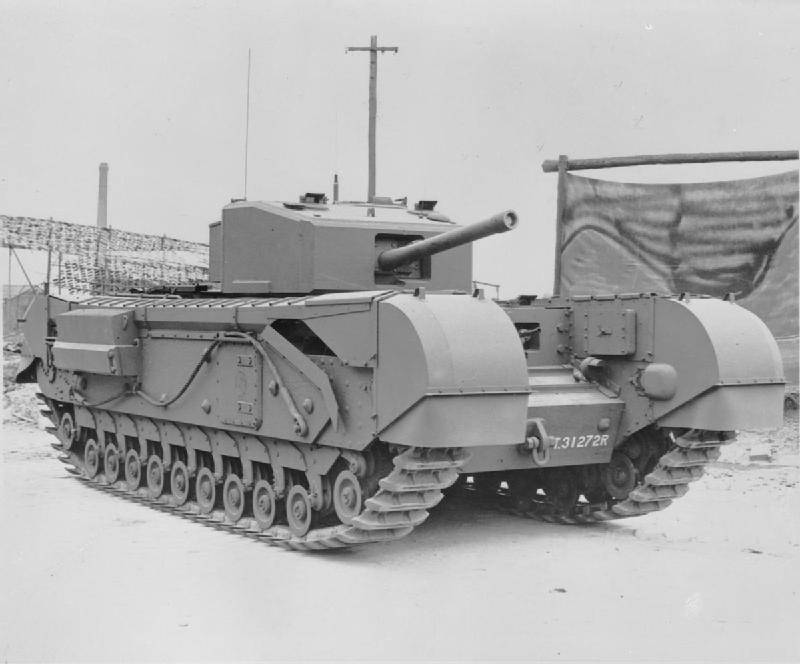
Heavy infantry tank "Churchill" modification Mk.III, which became the basis for engineering vehicles. Photo of Wikimedia Commons
An armored vehicle of the Churchill Mk.III type was chosen as the basis for an engineering tank. This tank had a welded turret in which a 57 mm QF 6 pounder gun was mounted. Also in the tower there was a coaxial rifle-caliber machine gun, sighting equipment and other necessary devices. The new project provided for the use of the existing tower, however, the internal volumes of the fighting compartment had to be redone in the most serious way.
The short-barrel Mortar Petard, used on the Chirchill AVRE engineering tank, could have thrown 290-mm ammunition only on the 70-72. The new military machine of military engineers had to send a similar projectile for a long distance, for which it was necessary to create the required weapon. The development of such a system has proven to be very difficult. A large-caliber gun, proposed for installation on an existing tank without significant modernization, should have appropriate recoil parameters and some other features. In addition, it was necessary to provide loading without the need to go beyond the protected volume. As a result, it took to introduce some new ideas.
Preliminary studies have shown that acceptable returns can only be obtained through the use of a new original recoilless rifle. In this case, it was possible to reduce the load on the design of the base machine, as well as to provide the required firing characteristics. However, the development of a new recoilless weapons failed to complete immediately. After completion of the project, it was necessary to change the design of this tool in order to achieve the required characteristics.
The new gun was proposed to be installed in the existing tower, along its longitudinal axis. At the same time, in the frontal parts of the tower there was an embrasure for the withdrawal of the barrel, and in the stern sheet there should have been a nozzle for ejection of powder gases that compensated for the recoil. This design of the turret and gun made it possible to produce circular guidance in the horizontal plane, as well as to raise the barrel at small elevation angles.
In the new project, it was proposed to use the existing explosive charge, created earlier for the Churchill AVRE engineering tank. The product, which had the unofficial name Flying Dustbin (“Flying trash can”), was a design of two cylindrical bodies with a subversive and propelling charge, connected by a longitudinal rod. The ammunition had a caliber of 290 mm and weighed 40 pounds (18,15 kg). The mass of the warhead was 28 pounds (12,7 kg).
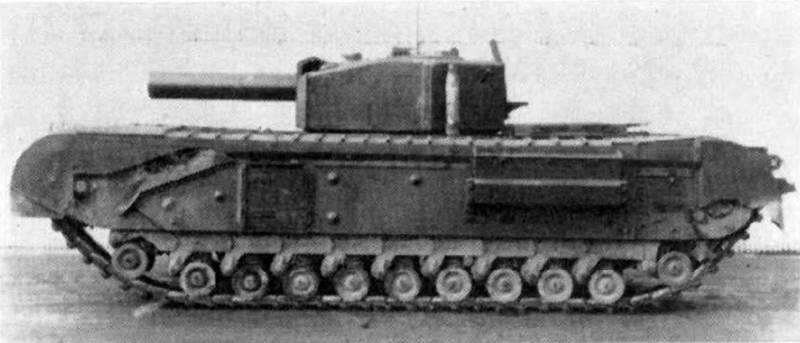
Engine tank, side view. Photo by Chamberlain P. Ellis C. Churchill and Sherman Specials // AFV Weapons Profile №20
For use with the new recoilless gun, the "Urna" was equipped with obturating belts, due to which the caliber was increased to 300 mm, and the weight increased to 20 kg. The task of these additional parts was to exclude gas breakthrough during firing in order to increase the muzzle energy and increase the firing range. No other improvements to the ammunition were provided, since the characteristics of this product were initially considered sufficient to solve the tasks assigned.
The gun for the Churchill Ardeer Aggie tank received a smooth barrel caliber 300 mm long 10 caliber. Inside the tower was placed the breech of the barrel with systems that allow it to separate from the nozzle for recharging. It was proposed to place the ammunition with the standard and additional propelling charges in the barrel chamber, after which the barrel and nozzle could be connected to execute the shot. When firing the shot, the “Flying urn” was supposed to pass through the barrel and head towards the target, and some of the powder gases were discharged through the turret of the turret.
According to reports, during the development of a new gun, British designers faced serious problems. So, it turned out that throwing an 18-kg ammunition with a recoilless weapon requires an extremely large charge of gunpowder. When using the existing design, the separate loading shot was unacceptably large and heavy. As a result, it was impossible to place acceptable ammunition inside the fighting compartment, and working with such items inside the fighting compartment was extremely difficult.
A way out of this situation was found. It was proposed to use anti-mass when shooting. Together with the ammunition and propellant charge in the gun should load a bag of sand of appropriate size and weight. When fired, he had to lock the barrel for some time, allowing the propellant charge to create the required pressure and throw the projectile. Then the anti-mass flew out of the nozzle, ensuring the removal of powder gases and compensating for the recoil momentum.
The use of sandbags, according to calculations, significantly reduced the size of the propellant charge. Moreover, in this case, it was possible to bring the size of the ammunition to usable values. The updated version of the gun suit the developers, after which they completed the design, and also began preparations for the construction of an experienced engineering tank.
The first prototype of the Churchill Ardeer Aggie was built in 1943 year. It was the chassis of the Churchill series version of the Mk.III with a modified turret, in which a new type of 300-mm recoilless gun was installed. In this form, the car went to the field tests, which were supposed to demonstrate the capabilities of technology.
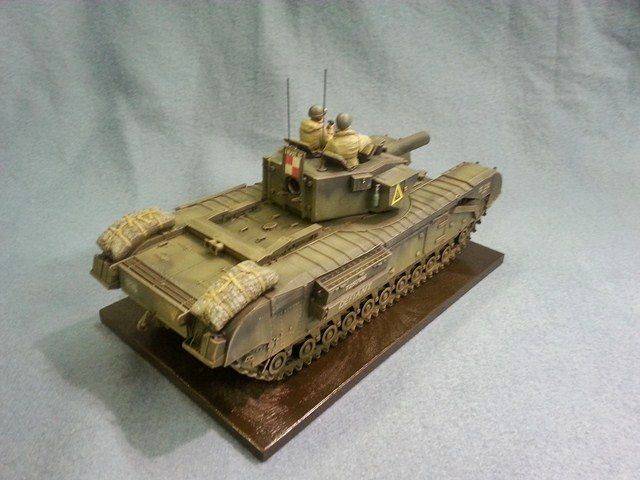
Modern layout of the Churchill Ardeer Aggie, view of the stern. You can see the nozzle guns. Photo Militarymodelling.com
Due to the lack of changes in the design of the chassis, the mobility of the tank remained at the current level. He was still able to move on the highway and rough terrain, cross trenches and wade through shallow bodies of water. However, the main focus of the tests was not on mobility, but on firepower. Test firing showed that the new gun can send the upgraded Flying Dustbin ammunition up to 450 yards (410 m). Thus, in comparison with the previous Churchill AVRE machine, the firing range was increased several times.
However, there were no complaints. During the tests, it turned out that the 300-mm recoilless gun was too large for the existing turret. There was not too much space left to accommodate the crew, which did not contribute to the convenience of his work. Loading a weapon with successive sending of ammunition, propellant charge and anti-mass into the barrel in a cramped turret was difficult. In addition, there were significant risks associated with contact with the barrel and other gun assemblies. During firing, the parts of the gun heated up, which could lead to burns, and an accidental touch of the barrel during a shot threatened with concussion or other injuries.
Things were no better on the outside of the tank. During the shot, high-speed incandescent powder gases, as well as anti-mass in the form of a sandbag as a whole or in a torn state, should have come out of the aft nozzle of the tower. Due to the large caliber of the gun, a plume of powder gases flew out to a distance of several tens of meters, which posed a great danger to everyone around. In the conditions of joint work of sappers and infantry, this could lead to injuries or even death of their own soldiers. Equipment with such features could not be recommended for adoption.
According to some reports, according to the test results, an attempt was made to improve the design of the gun and thereby protect the troops interacting with the Churchill Ardeer Aggie tanks. On the aft part of the tower, next to the nozzle, a box-shaped unit with an inclined rear sheet was installed, which was supposed to divert the powder gases back and up. Thanks to this equipment, a characteristic plume was to remain behind the tank during firing, but the risks to the troops were reduced. Also, apparently, during the modernization, an experienced tank received two sets of smoke grenade launchers installed on the front of the sides of the tower.
There is evidence that the updated Churchill Ardeer Aggie with a gas exhaust system was tested, but did not interest the military. The exact reasons for this decision, made on the basis of the results of new tests, are unknown. Probably, the proposed modernization made it possible to reduce the risks for the infantry, but the working conditions of the engineering tank's own crew were still unacceptable.
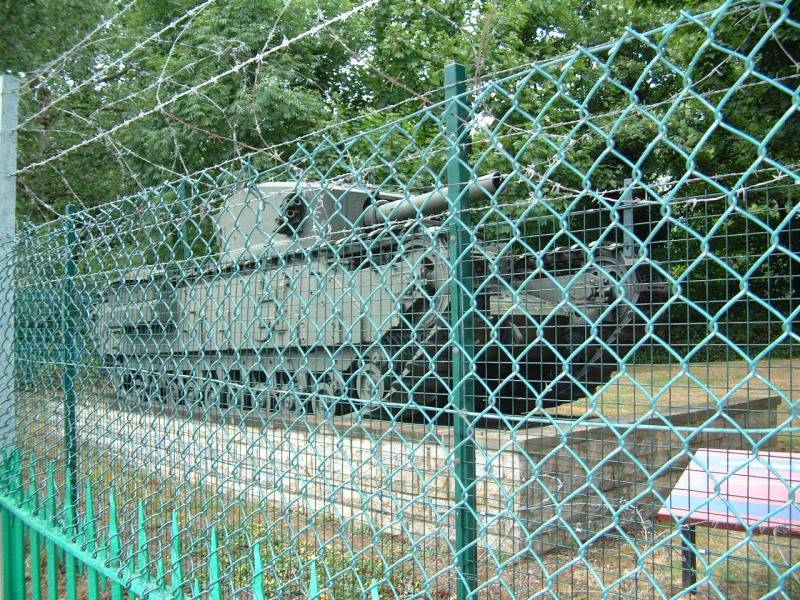
The Churchill-based museum engineering tank is supposedly the prototype of Churchill Ardeer Aggie. Photo Network54.com
An attempt to create a new weapon for throwing explosive charges designed to destroy enemy barriers and fortifications was unsuccessful. An engineering tank with a 300-mm gun entered the range and demonstrated a significant increase in firing range. At the same time, the machine had a number of characteristic flaws that prevented its operation outside the landfill. Moreover, some design problems made it difficult to use such a technique in any conditions.
The project of the engineering tank Churchill Ardeer Aggie did not interest the potential customer in the face of the Royal Engineers Corps. The first prototype, built and tested in the 1943 year, also became the last car of its type. The command of the Royal Engineers Corps decided that Churchill AVRE machines would be sufficient for solving the existing tasks. Until the end of the Second World War, the industries of Canada and Great Britain managed to produce several hundred of such machines that were actively used during the battles.
There is information according to which the only built engineering tank Churchill Ardeer Aggie has survived to this day in one of the British museums. The allegedly unique machine is stored at one of the sites of the Museum of the Corps of Royal Engineers in Chatham. There are several shots of this specimen taken through a mesh fence. For some reason, the tank is not included in the main exhibition and is not accessible to museum visitors under normal circumstances, which is why technology lovers had to photograph it through the fence. Characteristic features of this tank are a large box at the rear of the turret, which can be a gas exhaust system, as well as smoke grenade launchers on the sides of the turret.
However, there is reason to doubt that this is Churchill Ardeer Aggie. Some features of the car’s appearance suggest that this is the Churchill AVRE engineering tank of a late (possibly post-war) modification with a new type of weapon. Which of the versions is true - is unknown. Unfortunately, the British Museum is in no hurry to clarify the details.
Regardless of which armored vehicle is in Chatham, the Churchill Ardeer Aggie project did not produce noticeable results. The only sample of such an engineering tank demonstrated a relatively high firing range with dubious operational features. As a result, the tank did not go into mass production and could not supplement or replace the existing Churchill AVREs. Despite the successful solution of the main tasks of the project and the superiority in the main characteristics, the new version of the engineering tank could not go beyond the range.
On the materials of the sites:
http://ftr.wot-news.com/
http://closecombatseries.net/
http://strangernn.livejournal.com/
Chamberlain P. Ellis C. Churchill and Sherman Specials // AFV Weapons Profile No. XXUMX. Profile Publications. 20.
Information